UNITED STATES
SECURITIES AND EXCHANGE COMMISSION
Washington, D.C. 20549
FORM N-CSR
CERTIFIED SHAREHOLDER REPORT OF
REGISTERED
MANAGEMENT INVESTMENT COMPANIES
Investment Company Act File Number: 811-04998
| T. Rowe Price Spectrum Fund, Inc. |
|
|
| (Exact name of registrant as specified in charter) |
| 100 East Pratt Street, Baltimore, MD 21202 |
|
|
| (Address of principal executive offices) |
| David Oestreicher |
| 100 East Pratt Street, Baltimore, MD 21202 |
|
|
| (Name and address of agent for service) |
Registrant’s telephone number, including
area code: (410) 345-2000
Date of fiscal year end:
December 31
Date of reporting period: December 31, 2013
Item 1. Report to Shareholders
 |
|
Spectrum
Fund |
December
31, 2013 |
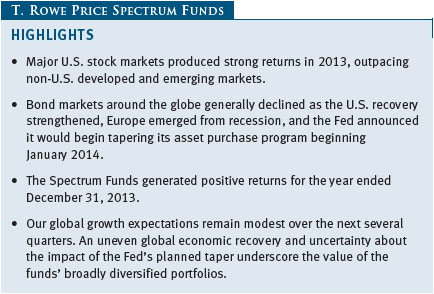
The views and opinions in this report were current as of December 31, 2013. They are not guarantees of performance or investment results and should not be taken as investment advice. Investment decisions reflect a variety of factors, and the managers reserve the right to change their views about individual stocks, sectors, and the markets at any time. As a result, the views expressed should not be relied upon as a forecast of the fund’s future investment intent. The report is certified under the Sarbanes-Oxley Act, which requires mutual funds and other public companies to affirm that, to the best of their knowledge, the information in their financial reports is fairly and accurately stated in all material respects.
REPORTS ON THE WEB
Sign up for our E-mail Program, and you can begin to receive updated fund reports and prospectuses online rather than through the mail. Log in to your account at troweprice.com for more information.
Manager’s Letter
Fellow Shareholders
Major U.S. stock markets produced strong returns in 2013. Although corporate earnings growth moderated, investors remained optimistic about the economy. Stocks in non-U.S. developed markets underperformed U.S. shares but still produced good returns. Emerging markets stocks declined slightly for the year, significantly underperforming developed markets. U.S. bonds produced mostly negative returns as yields rose due to the strengthening economy and the expectations of Fed tapering. Non-U.S. developed and emerging markets bonds fell for the year. The Spectrum Growth Fund outpaced its benchmark and peer group for the six-month period but trailed for the year ended December 31, 2013. The Spectrum Income Fund led its benchmark and peer group for both periods, while the Spectrum International Fund outperformed its benchmark for both periods but trailed its peer group.
MARKET ENVIRONMENT
U.S. equities generated strong returns in 2013, lifted by steady labor market gains, favorable corporate earnings, and supportive monetary policies from the Fed and other major central banks. The U.S. economy grew at a moderate pace, overcoming the higher taxes and federal spending reductions that took effect in the first quarter of 2013, as well as the government shutdown and debt ceiling showdown in October. In mid-December, investors and stock markets reacted favorably as the Fed decided to slowly taper its monthly $85 billion in asset purchases starting in January 2014 and keep short-term interest rates low. In addition, Congress approved a bipartisan two-year budget deal after years of brinkmanship over fiscal policy.
As measured by various Russell indexes, growth stocks outperformed value stocks across all market capitalizations, especially among small-caps, which exceeded mid- and large-caps. All S&P 500 sectors produced positive returns. Based on total return data from S&P, the consumer discretionary, health care, and industrials and business services sectors performed best. The utilities and telecommunication services sectors advanced the least.
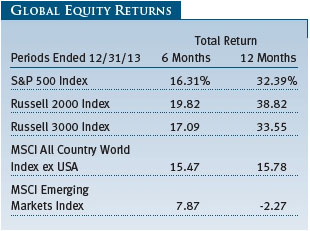
Non-U.S. developed stock markets underperformed U.S. shares but still produced good returns. In the eurozone, Germany and the Netherlands, and peripheral markets Greece and Ireland, were among the top performers, as the currency union emerged from recession. Developed Asian markets lagged, but Japanese equities led the region with solid gains in dollar terms. Demand for the country’s exports improved as the yen declined against the dollar due to highly accommodative policies enacted by Prime Minister Shinzo Abe and the Bank of Japan. Japan also benefited from economic improvement in the U.S. and Europe. Emerging Asian markets outperformed the broad emerging markets universe, albeit with tepid gains overall. Emerging Europe declined and Latin America lagged, hurt by reduced commodities demand from China.
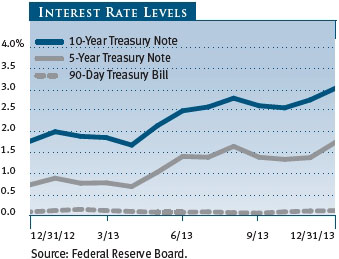
U.S. bonds produced mostly negative returns over the last year. Intermediate- and long-term Treasury yields rose due to the strengthening economy and expectations that the Fed will begin curtailing its stimulus measures. High yield bonds significantly outperformed higher-quality issues, as the asset class benefited from its lower sensitivity to interest rate changes and strong demand for higher-yielding securities. Corporate, agency mortgage-backed, and municipal securities declined but held up better than Treasuries. Asset-backed securities were mostly flat.
Bonds in non-U.S. developed markets produced losses in dollar terms. Japanese bond yields were volatile due to the government’s unprecedented actions to stop deflation and reach a 2% inflation target within two years. European bonds outperformed as borrowing costs in troubled eurozone economies declined, the eurozone emerged from recession, and stronger currencies benefited U.S. dollar-based investors. Emerging markets bonds underperformed bonds in non-U.S. developed markets. Concerns about Fed tapering caused investors to reduce their exposure to the asset class, and most emerging markets currencies declined versus the dollar, especially those of countries that depend on external financing of their current account deficits.
SPECTRUM GROWTH FUND
The Spectrum Growth Fund posted a positive 28.59% return for the 12 months ended December 31, 2013, trailing the Russell 3000 Index and its peer group, the Lipper Multi-Cap Core Funds Index. Our inclusion of diversifying sectors, not represented by the benchmark, particularly non-U.S. equities, weighed on results. The Emerging Markets Stock, International Stock, and International Growth & Income Funds each underperformed their benchmarks. In addition, our exposure to real assets equities (companies that own or whose sales are related to assets with physical properties such as energy and natural resources, commodities, real estate, basic materials, equipment, utilities, and infrastructure) detracted from relative performance as slow global growth weighed on the energy and materials sectors during the year. Security selection within our large-cap U.S. equities allocation contributed the most to positive relative performance through our underlying portfolios, notably the Blue Chip Growth, Growth Stock, and Value Funds.
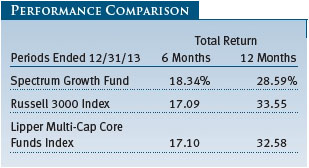
The Spectrum Growth Fund invests in a range of underlying funds that focus on domestic stocks across all market capitalizations and international stocks in developed and emerging markets.
Based on favorable valuations outside the U.S., we increased our overweight in non-U.S. relative to U.S. equities as European countries are in the early stages of recovery. However, we have further trimmed our overweight to emerging markets relative to developed equity markets in light of slowing emerging markets growth and the continued potential for Fed tapering to weigh on emerging markets currencies. Although valuations in emerging markets remain attractive compared with developed markets, we anticipate greater differentiation among them, as major commodity exporters may face headwinds due in part to increased global energy production.
We continue to favor domestic growth stocks over value stocks as a low-growth economy typically benefits growth stocks more than value shares; however, we have trimmed that overweight as the prospects for improving economic growth have moderated the anticipated advantage. Valuations currently favor large-cap stocks over small-caps, as the latter’s solid performance over the last few years has led to rich valuations in the small-cap universe.
U.S. growth expectations remain modest as the economy continues to improve amid diminishing fiscal headwinds and continuing labor market recovery. U.S. corporate balance sheets and profit margins remain healthy. Earnings and revenue growth in the mid-single digits are consistent with modest economic growth, and U.S. equity valuations are fairly valued relative to historical levels.
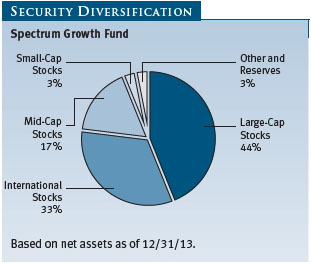
We are underweight real assets stocks versus global equities, as the prospects for muted global economic growth and an increase in global energy production may weigh on commodity prices. Demand for commodities from China is expected to remain subdued as it shifts its growth model away from industrial production and exports to domestic consumption. Although real estate investment trusts benefit from gradual economic improvement, current valuations are still relatively expensive. Over the long term, we believe that exposure to real assets equities, such as real estate, energy, and natural resources, expands the fund’s broad diversification and positioned it to perform well under a variety of market conditions, including periods of rising inflation.
SPECTRUM INCOME FUND
The Spectrum Income Fund returned 3.02% for the 12 months ended December 31, 2013, substantially outpacing the Barclays U.S. Aggregate Bond Index and its peer group, the Lipper Multi-Sector Income Funds Average. Allocations to diversifying sectors to gain exposure to a broad range of income sources—such as dividend-paying stocks, high yield bonds, and non-U.S. debt—are key features of the Spectrum Income Fund’s design. Our holdings in the Equity Income and High Yield Funds drove strong relative performance versus the Barclays index, which represents the broad U.S. investment-grade bond market. This was partly offset, however, by exposure to emerging market bonds, which underperformed. Our tactical underweight to long-term Treasury bonds helped reduce exposure to rising interest rate risk and bolstered performance as long-term yields rose in the spring sending Treasury prices lower. Our decision to overweight dividend-paying equities versus bonds helped relative results as equities outperformed fixed income over the period. Security selection detracted from relative results within a number of the underlying funds, particularly the Equity Income and International Bond Funds.
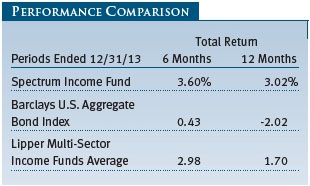
In keeping with our strategy to gain exposure to income sources beyond the benchmark, we continue to favor high yield bonds versus investment-grade bonds. High yield debt remains attractive versus other fixed income sectors in this low-yield environment, particularly in light of our expectations for a gradually improving economy. In addition, many high yield issuers have improved their financial conditions significantly since the 2008 global financial crisis, taking advantage of low interest rates to refinance debt and extend maturities. Also, the tendency for high yield debt to be less sensitive to changes in interest rates is appealing given that interest rates are near historical lows. We are neutral toward emerging markets debt versus investment-grade bonds. While valuations are attractive, emerging market bonds are susceptible to capital outflows as interest rates rise and many emerging economies continue to struggle with containing inflationary pressures.
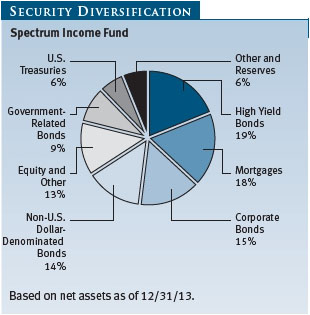
We currently favor U.S. investment-grade bonds versus non-U.S. dollar-denominated debt. This is based largely on the prospects for a stronger U.S. dollar and supported by expectations for improving growth and the potential for higher rates in the U.S. as the Fed’s tapering program evolves.
SPECTRUM INTERNATIONAL FUND
The Spectrum International Fund returned 18.17% for the 12 months ended December 31, 2013, outperforming its benchmark, the MSCI All Country World Index ex USA, but slightly lagging its Lipper peer group. Among the top contributors to relative performance were underlying funds focused primarily on non-U.S. developed markets, including the European Stock, Japan, and International Discovery Funds. Europe generated strong returns as it emerged from recession, with a number of eurozone and periphery countries generating strong returns. The Japanese market rose on improved profitability among export-oriented firms as the yen declined against the dollar due to the government’s accommodative monetary policies. Although emerging markets generally underperformed developed markets, the Africa & Middle East Fund was a strong performer and aided returns, particularly as investments within the United Arab Emirates and Qatar climbed dramatically. The Latin America, New Asia, and Emerging Markets Stock Funds lagged.
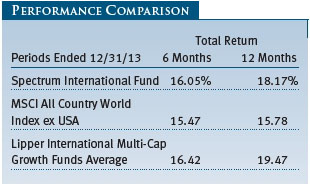
At the close of the period, Europe was our largest regional exposure, followed by Pacific ex Japan, and then Japan. While European economic growth remains sluggish, hindered by high debt loads and unemployment, deflation worries, and persistent challenges in the eurozone periphery, a number of countries show signs of positive growth. In Japan, although fiscal and monetary policies have revived consumer spending and economic output, sustainability will depend on the passage of structural reforms. We continue to be overweight to emerging markets equities given attractive valuations relative to developed markets, although this attraction is tempered by slowing growth and the potential for Fed tapering to weigh on emerging markets currencies. Considerable disparity exists in the strength of various emerging markets economies, with commodity producers challenged by weaker demand.
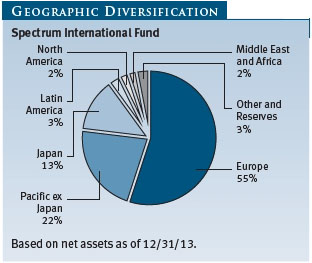
OUTLOOK
Our expectations for global growth in the coming quarters remain modest. The U.S. economy is gradually recovering, supported by positive data on the labor and housing markets, which have benefited from subdued energy prices. We believe fiscal headwinds from some federal tax increases and spending cuts last year have abated. Although the Fed has pledged to keep short-term interest rates low, we expect upward pressure on long-term interest rates as the Fed reduces its asset purchases. U.S. corporate balance sheets and profit margins are healthy. Equity markets are fairly valued and earnings growth is likely to be moderate, consistent with modest economic growth.
Non-U.S. developed economies are slowly improving, though they rely heavily on supportive fiscal and monetary policy. While the eurozone emerged from recession at midyear, as noted earlier, the macroeconomic environment in Europe remains challenging. In Japan, gross domestic product growth is expected to remain positive into 2014 as anti-deflation policies by Prime Minister Shinzo Abe and the Bank of Japan—dubbed Abenomics, with its “three arrows” of aggressive monetary easing, fiscal stimulus, and structural reform—are implemented.
Many emerging markets economies are facing slower growth and appear vulnerable to the prospect of rising U.S. rates. We believe that the worst of China’s economic slowdown has passed, and we are starting to see better numbers as the country charts a path toward more sustainable growth rates. Demand for commodities, though, is expected to remain subdued as China shifts its growth model away from industrial production in favor of domestic consumption.
While we expect central bank monetary policies to remain accommodative for some time, the impact of the Fed’s tapering may periodically elevate market volatility. However, we believe that an uneven global recovery and prevailing geopolitical uncertainty underscore the value of the Spectrum Funds’ diversified holdings.
Thank you for investing with T. Rowe
Price.
Charles M. Shriver
Portfolio manager, Spectrum Growth, Spectrum Income, and Spectrum International Funds
January 24, 2014
The committee chairman has day-to-day responsibility for managing the portfolios and works with committee members in developing and executing the funds’ investment program.
RISKS OF INVESTING
As with all stock and bond mutual funds, each fund’s share price can fall because of weakness in the stock or bond markets, a particular industry, or specific holdings. Stock markets can decline for many reasons, including adverse political or economic developments, changes in investor psychology, or heavy institutional selling. The prospects for an industry or company may deteriorate because of a variety of factors, including disappointing earnings or changes in the competitive environment. In addition, the investment manager’s assessment of companies held in a fund may prove incorrect, resulting in losses or poor performance even in rising markets.
Bonds are subject to interest rate risk, the decline in bond prices that usually accompanies a rise in interest rates, and credit risk, the chance that any fund holding could have its credit rating downgraded or that a bond issuer will default (fail to make timely payments of interest or principal), potentially reducing the fund’s income level and share price. High yield corporate bonds could have greater price declines than funds that invest primarily in high-quality bonds. Companies issuing high yield bonds are not as strong financially as those with higher credit ratings, so the bonds are usually considered speculative investments.
Funds that invest overseas may carry more risk than funds that invest strictly in U.S. assets. Risks can result from varying stages of economic and political development; differing regulatory environments, trading days, and accounting standards; and higher transaction costs of non-U.S. markets. Non-U.S. investments are also subject to currency risk, or a decline in the value of a foreign currency versus the U.S. dollar, which reduces the dollar value of securities denominated in that currency.
GLOSSARY
Barclays U.S. Aggregate Bond Index: An unmanaged index that tracks investment-grade corporate and government bonds.
Gross domestic product: The total market value of all goods and services produced in a country in a given year.
J.P. Morgan Non-U.S. Dollar Government Bond Index: An unmanaged index that tracks the performance of major non-U.S. bond markets.
Lipper averages: The averages of available mutual fund performance returns for specified time periods in categories defined by Lipper Inc.
Lipper indexes: Fund benchmarks that consist of a small number of the largest mutual funds in a particular category as tracked by Lipper Inc.
MSCI All Country World Index ex USA: An index that measures equity market performance of developed and emerging countries, excluding the U.S.
MSCI EAFE Index: An unmanaged index that tracks the stocks of about 1,000 companies in Europe, Australasia, and the Far East (EAFE).
MSCI Emerging Markets Index: An unmanaged index that tracks stocks in 26 emerging market countries.
Russell 2000 Index: An unmanaged index that tracks the stocks of 2,000 small U.S. companies.
Russell 3000 Index: An index that tracks the performance of the 3,000 largest U.S. companies, representing approximately 98% of the investable U.S. equity market.
S&P 500 Index: An unmanaged index that tracks the stocks of 500 U.S. primarily large-cap companies.
Weighted average effective duration (years): A measure of a security’s price sensitivity to changes in interest rates. Securities with longer durations are more sensitive to changes in interest rates than securities of shorter durations.
Weighted average maturity: A measure of a fund’s interest rate sensitivity. In general, the longer the average maturity, the greater the fund’s sensitivity to interest rate changes. The weighted average maturity may take into account interest rate readjustment dates for certain securities. Money funds must maintain a weighted average maturity of less than 60 days.
Note: MSCI makes no express or implied warranties or representations and shall have no liability whatsoever with respect to any MSCI data contained herein. The MSCI data may not be further redistributed or used as a basis for other indices or any securities or financial products. This report is not approved, reviewed, or produced by MSCI.
Note: Russell Investment Group is the source and owner of the trademarks, service marks, and copyrights related to the Russell indexes. Russell® is a trademark of Russell Investment Group.
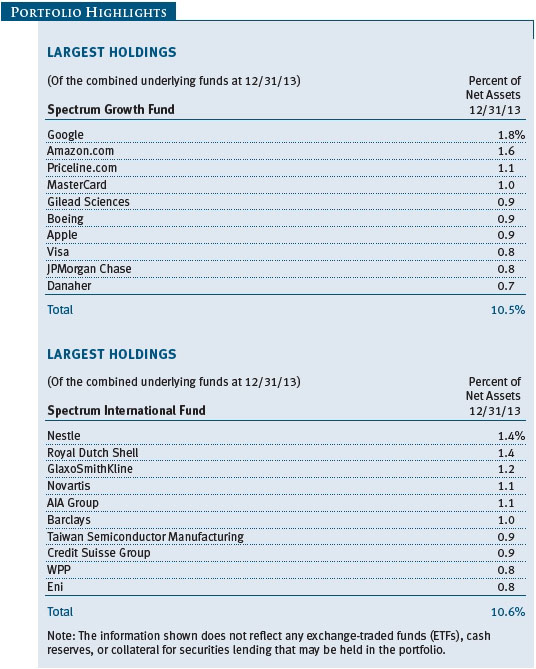
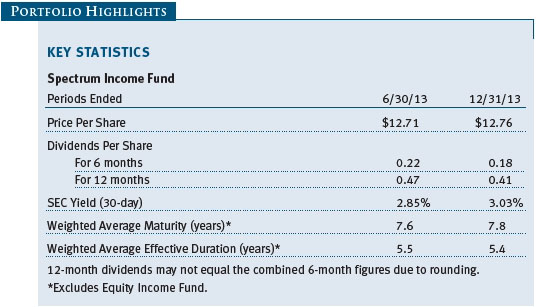
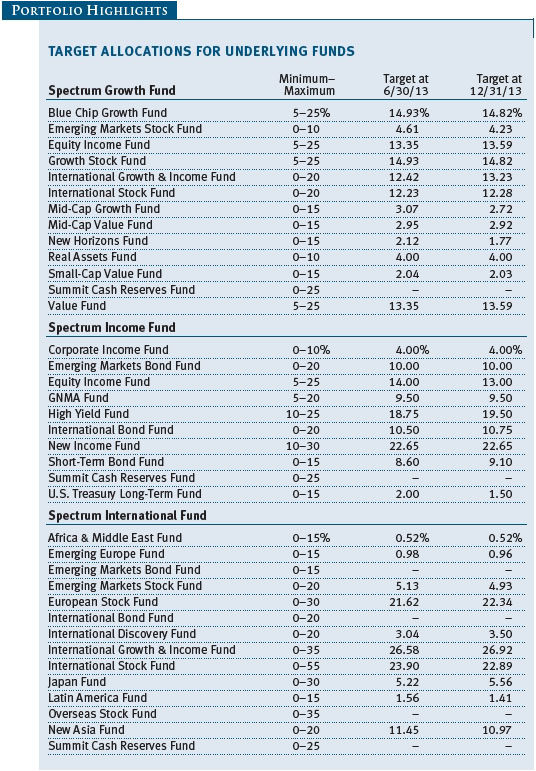
Performance and Expenses
| Growth of $10,000 |
This chart shows the value of a hypothetical $10,000 investment in the fund over the past 10 fiscal year periods or since inception (for funds lacking 10-year records). The result is compared with benchmarks, which may include a broad-based market index and a peer group average or index. Market indexes do not include expenses, which are deducted from fund returns as well as mutual fund averages and indexes.
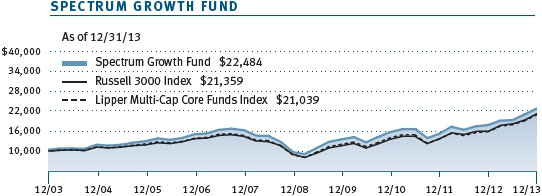
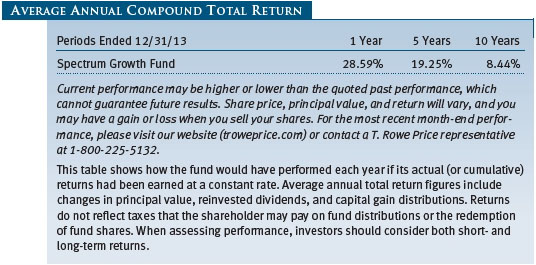
| Growth of $10,000 |
This chart shows the value of a hypothetical $10,000 investment in the fund over the past 10 fiscal year periods or since inception (for funds lacking 10-year records). The result is compared with benchmarks, which may include a broad-based market index and a peer group average or index. Market indexes do not include expenses, which are deducted from fund returns as well as mutual fund averages and indexes.
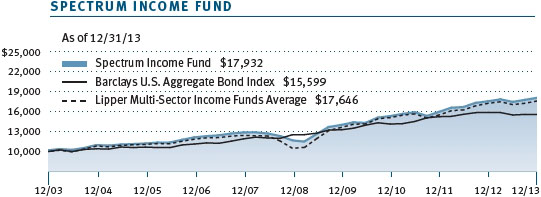
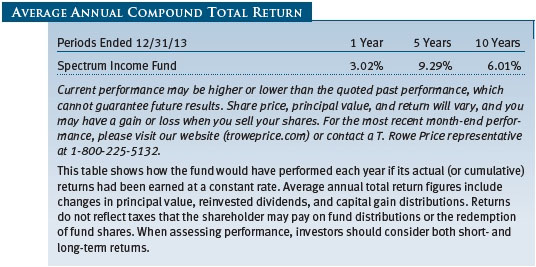
| Growth of $10,000 |
This chart shows the value of a hypothetical $10,000 investment in the fund over the past 10 fiscal year periods or since inception (for funds lacking 10-year records). The result is compared with benchmarks, which may include a broad-based market index and a peer group average or index. Market indexes do not include expenses, which are deducted from fund returns as well as mutual fund averages and indexes.
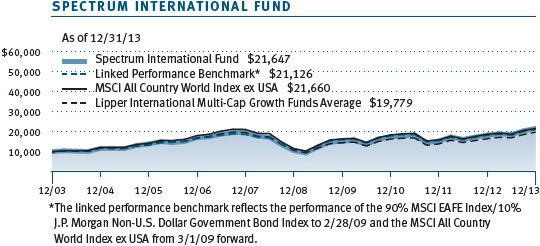
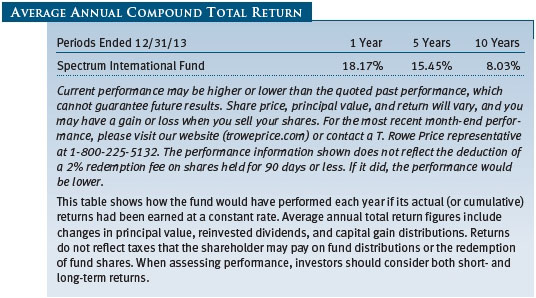

| Fund Expense Example |
As a mutual fund shareholder, you may incur two types of costs: (1) transaction costs, such as redemption fees or sales loads, and (2) ongoing costs, including management fees, distribution and service (12b-1) fees, and other fund expenses. The following example is intended to help you understand your ongoing costs (in dollars) of investing in the fund and to compare these costs with the ongoing costs of investing in other mutual funds. The example is based on an investment of $1,000 invested at the beginning of the most recent six-month period and held for the entire period.
Actual
Expenses
The first line of the
following table (Actual) provides information about actual account values and
expenses based on the fund’s actual returns. You may use the information on this
line, together with your account balance, to estimate the expenses that you paid
over the period. Simply divide your account value by $1,000 (for example, an
$8,600 account value divided by $1,000 = 8.6), then multiply the result by the
number on the first line under the heading “Expenses Paid During Period” to
estimate the expenses you paid on your account during this period.
Hypothetical Example for
Comparison Purposes
The information
on the second line of the table (Hypothetical) is based on hypothetical account
values and expenses derived from the fund’s actual expense ratio and an assumed
5% per year rate of return before expenses (not the fund’s actual return). You
may compare the ongoing costs of investing in the fund with other funds by
contrasting this 5% hypothetical example and the 5% hypothetical examples that
appear in the shareholder reports of the other funds. The hypothetical account
values and expenses may not be used to estimate the actual ending account
balance or expenses you paid for the period.
Note: T. Rowe Price charges an annual account service fee of $20, generally for accounts with less than $10,000. The fee is waived for any investor whose T. Rowe Price mutual fund accounts total $50,000 or more; accounts electing to receive electronic delivery of account statements, transaction confirmations, prospectuses, and shareholder reports; or accounts of an investor who is a T. Rowe Price Preferred Services, Personal Services, or Enhanced Personal Services client (enrollment in these programs generally requires T. Rowe Price assets of at least $100,000). This fee is not included in the accompanying table. If you are subject to the fee, keep it in mind when you are estimating the ongoing expenses of investing in the fund and when comparing the expenses of this fund with other funds.
You should also be aware that the expenses shown in the table highlight only your ongoing costs and do not reflect any transaction costs, such as redemption fees or sales loads. Therefore, the second line of the table is useful in comparing ongoing costs only and will not help you determine the relative total costs of owning different funds. To the extent a fund charges transaction costs, however, the total cost of owning that fund is higher.
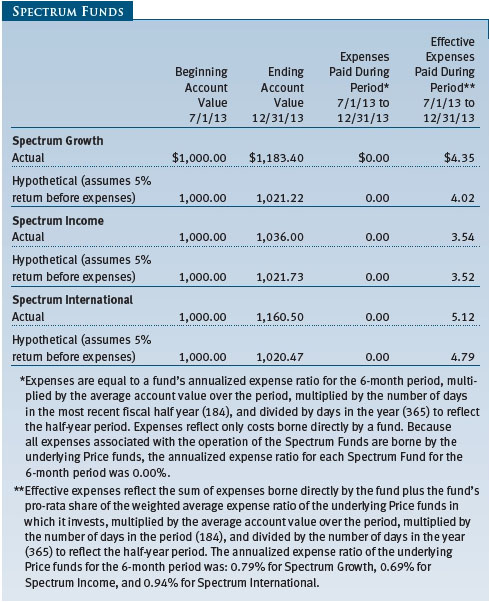
| T. Rowe Price Spectrum Growth Fund |
|
|
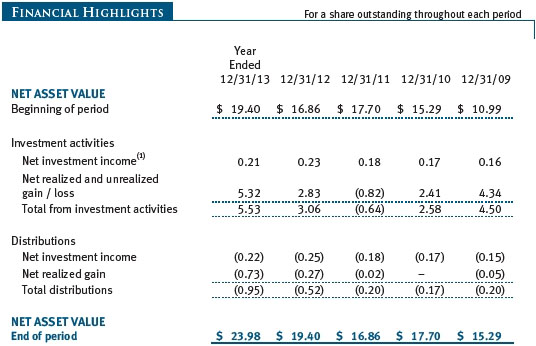

The accompanying notes are an integral part of these financial statements.
| T. Rowe Price Spectrum Income Fund |
|
|
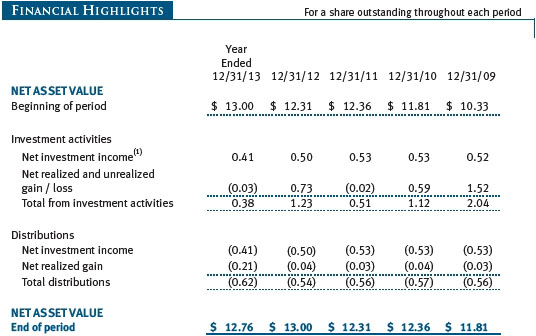
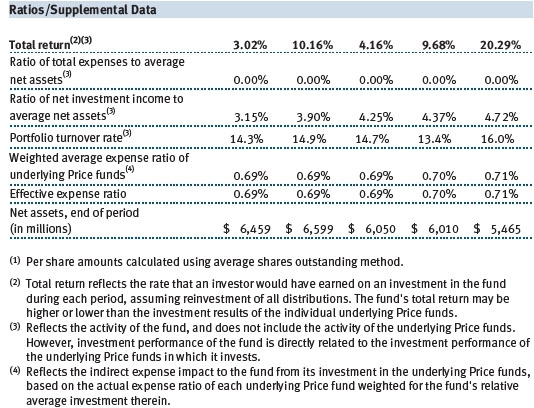
The accompanying notes are an integral part of these financial statements.
| T. Rowe Price Spectrum International Fund |
|
|
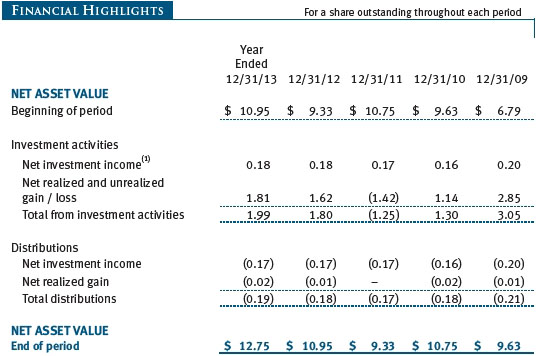
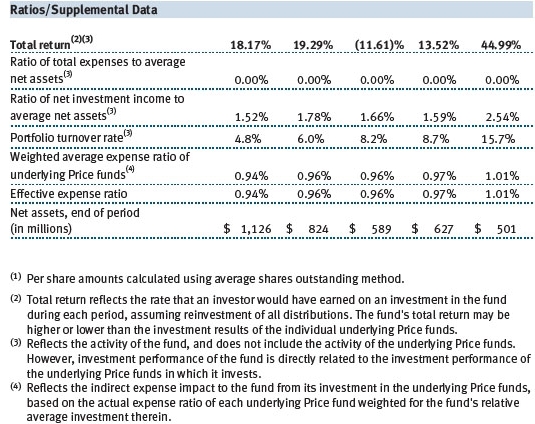
The accompanying notes are an integral part of these financial statements.
| T. Rowe Price Spectrum Growth Fund |
|
|
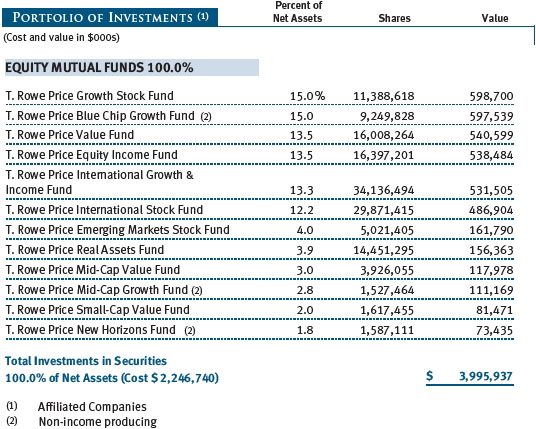
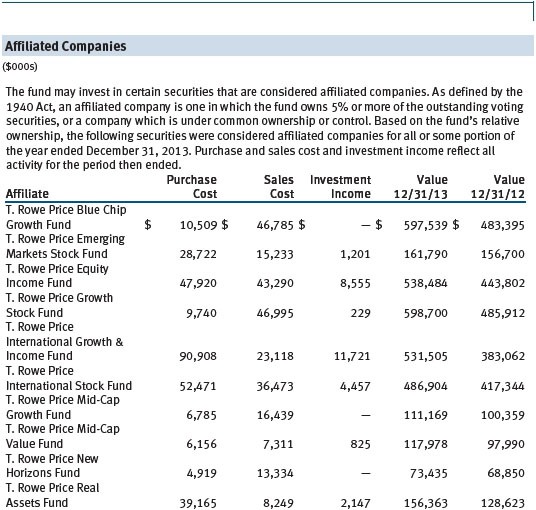
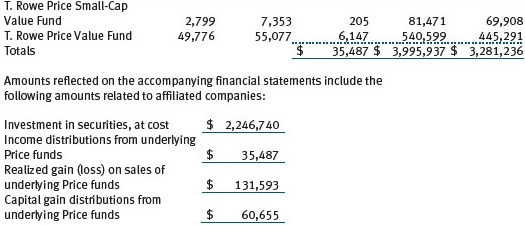
The accompanying notes are an integral part of these financial statements.
| T. Rowe Price Spectrum Income Fund |
|
|
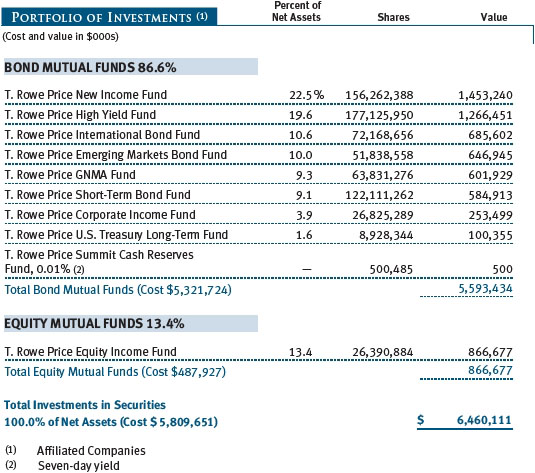
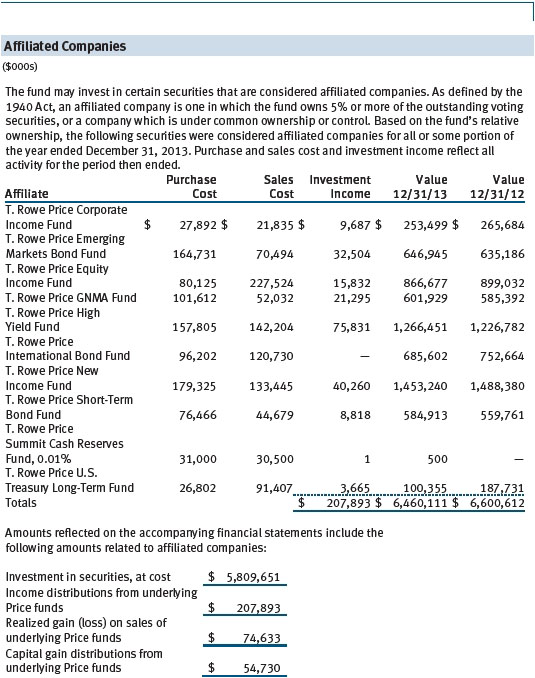
The accompanying notes are an integral part of these financial statements.
| T. Rowe Price Spectrum International Fund |
|
|

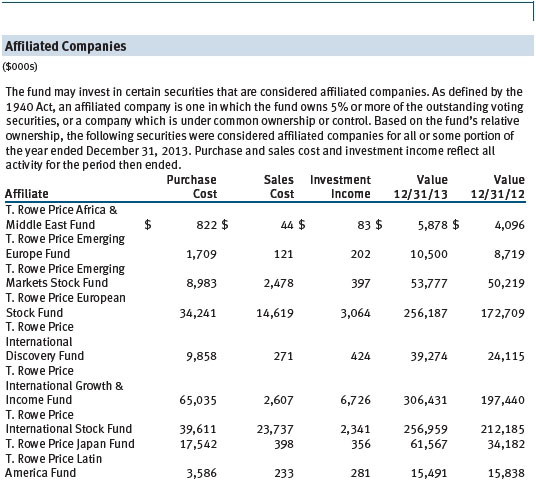
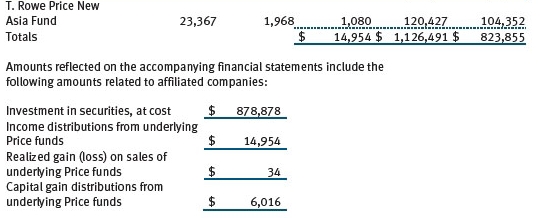
The accompanying notes are an integral part of these financial statements.
| T. Rowe Price Spectrum Growth Fund |
|
|
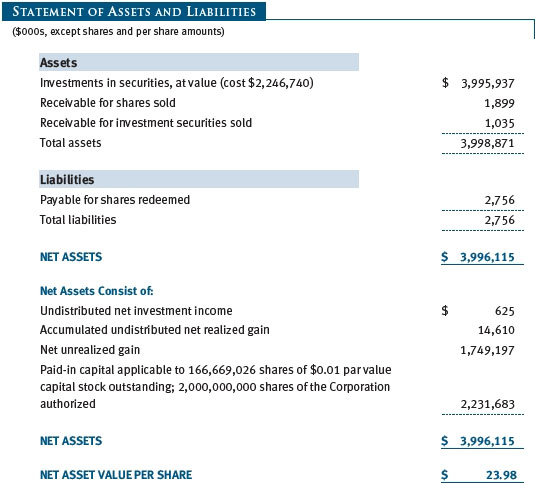
The accompanying notes are an integral part of these financial statements.
| T. Rowe Price Spectrum Income Fund |
|
|
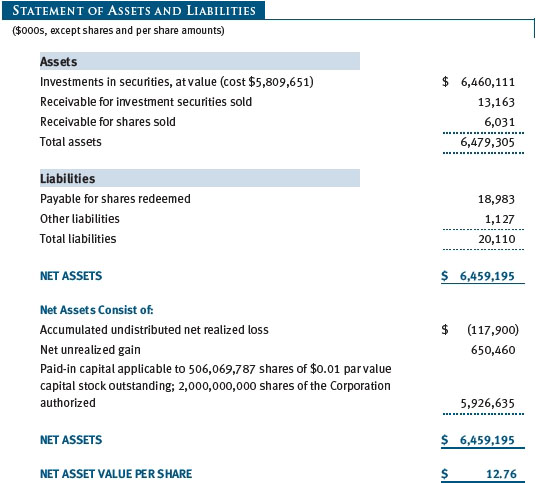
The accompanying notes are an integral part of these financial statements.
| T. Rowe Price Spectrum International Fund |
|
|
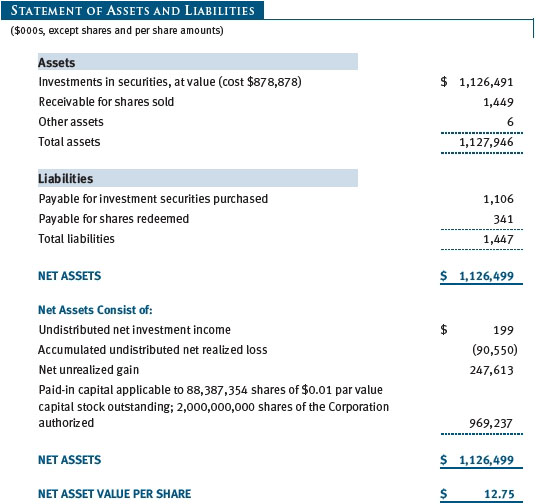
The accompanying notes are an integral part of these financial statements.
| T. Rowe Price Spectrum Growth Fund |
|
|
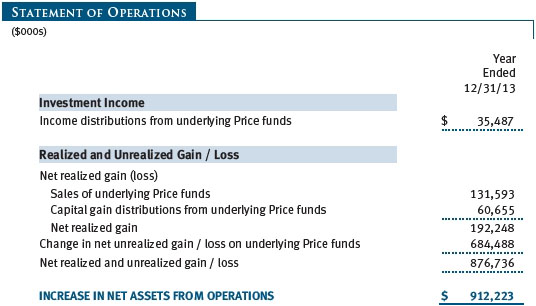
The accompanying notes are an integral part of these financial statements.
| T. Rowe Price Spectrum Income Fund |
|
|
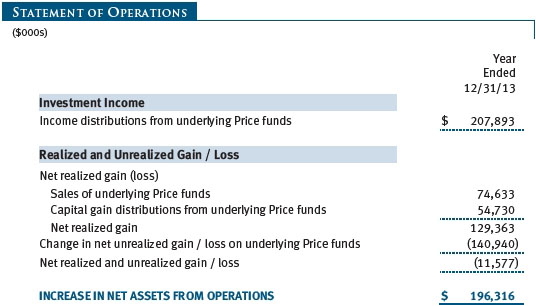
The accompanying notes are an integral part of these financial statements.
| T. Rowe Price Spectrum International Fund |
|
|
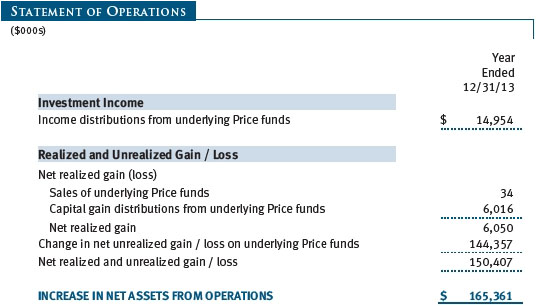
The accompanying notes are an integral part of these financial statements.
| T. Rowe Price Spectrum Growth Fund |
|
|
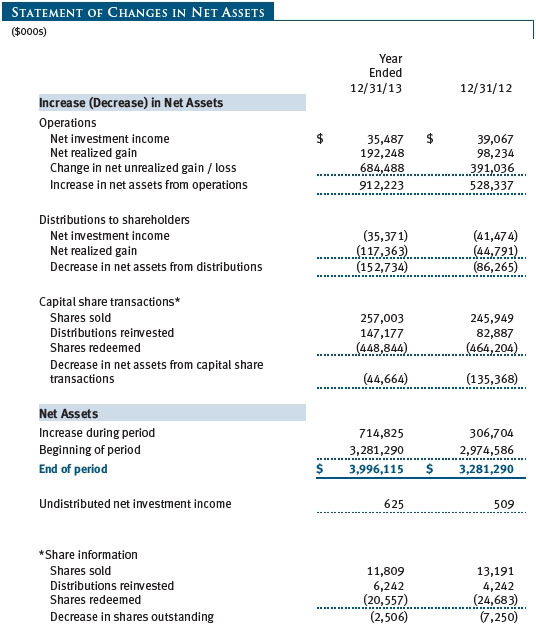
The accompanying notes are an integral part of these financial statements.
| T. Rowe Price Spectrum Income Fund |
|
|
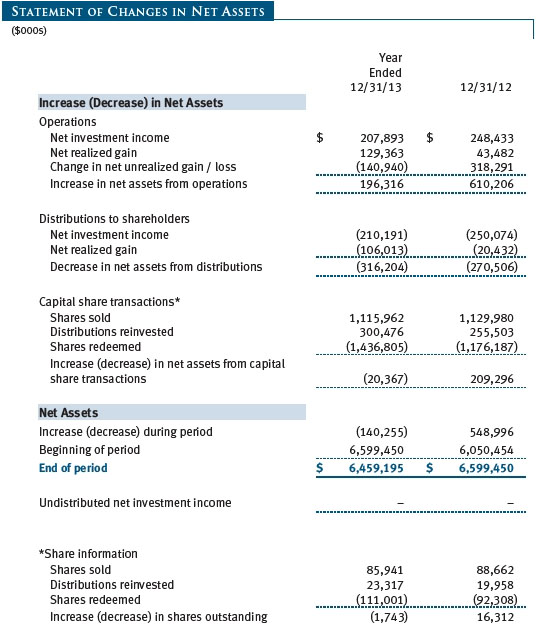
The accompanying notes are an integral part of these financial statements.
| T. Rowe Price Spectrum International Fund |
|
|
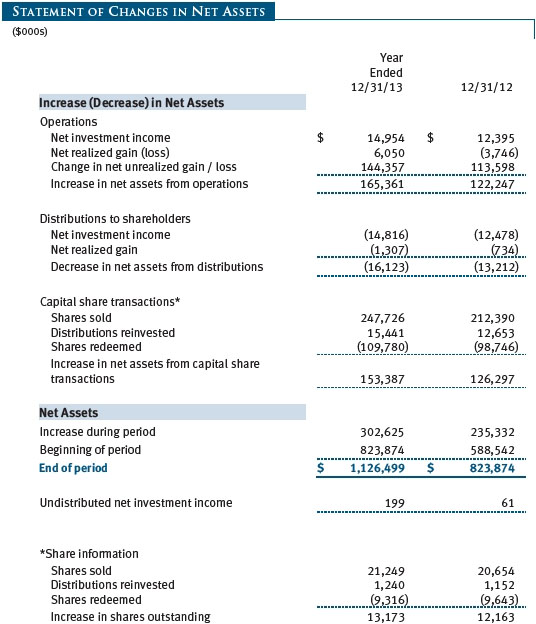
The accompanying notes are an integral part of these financial statements.
| Notes to Financial Statements |
T. Rowe Price Spectrum Fund, Inc. (the corporation), is registered under the Investment Company Act of 1940 (the 1940 Act) as an open-end management investment company. Spectrum Growth Fund, Spectrum Income Fund, and Spectrum International Fund (collectively, the Spectrum Funds) are three portfolios established by the corporation. Spectrum Growth and Spectrum Income commenced operations on June 29, 1990, and Spectrum International commenced operations on December 31, 1996.
The Spectrum Funds are nondiversified for purposes of the 1940 Act, due to their limited number of investments, respectively; however, each Spectrum Fund diversifies its assets within set limits among the specific underlying T. Rowe Price funds (underlying Price funds) in which it invests. Spectrum Growth seeks long-term capital appreciation and growth of income with current income a secondary objective. Spectrum Income seeks a high level of current income with moderate share price fluctuation. Spectrum International seeks long-term capital appreciation.
NOTE 1 - SIGNIFICANT ACCOUNTING POLICIES
Basis of Preparation The fund is an investment company and follows accounting and reporting guidance in the Financial Accounting Standards Board Accounting Standards Codification Topic 946 (ASC 946). The accompanying financial statements were prepared in accordance with accounting principles generally accepted in the United States of America (GAAP), including but not limited to ASC 946. GAAP requires the use of estimates made by management. Management believes that estimates and valuations of the underlying Price funds are appropriate; however, actual results may differ from those estimates, and the valuations reflected in the accompanying financial statements may differ from the value ultimately realized upon sale of the underlying Price funds.
Investment Transactions, Investment Income, and Distributions Income is recorded on the accrual basis. Income and capital gain distributions from the underlying Price funds are recorded on the ex-dividend date. Purchases and sales of the underlying Price funds are accounted for on the trade date. Gains and losses realized on sales of the underlying Price funds are reported on the identified cost basis. Income tax-related interest and penalties, if incurred, would be recorded as income tax expense. Distributions to shareholders are recorded on the ex-dividend date. Income distributions are declared by Spectrum Income daily and paid monthly. Income distributions are declared and paid by Spectrum Growth and Spectrum International annually. Capital gain distributions, if any, generally are declared and paid by each fund annually.
Redemption Fees A 2% fee is assessed on redemptions of Spectrum International shares held for 90 days or less to deter short-term trading and to protect the interests of long-term shareholders. Redemption fees are withheld from proceeds that shareholders receive from the sale or exchange of fund shares and are paid to the fund. Redemption fees received by Spectrum International are allocated to each underlying Price fund in proportion to the average daily value of its shares owned by the fund. Accordingly, redemption fees have no effect on the net assets of Spectrum International. The fees may cause the redemption price per share to differ from the net asset value per share.
NOTE 2 - VALUATION
Each fund’s financial instruments are valued, and its net asset value (NAV) per share is computed at the close of the New York Stock Exchange (NYSE), normally 4 p.m. ET, each day the NYSE is open for business. Each fund’s financial instruments are reported at fair value, which GAAP defines as the price that would be received to sell an asset or paid to transfer a liability in an orderly transaction between market participants at the measurement date. Investments in the underlying Price funds are valued at their closing NAV per share on the day of valuation.
The T. Rowe Price Valuation Committee (the Valuation Committee) has been established by the funds’ Board of Directors (the Board) to ensure that financial instruments are appropriately priced at fair value in accordance with GAAP and the 1940 Act. Subject to oversight by the Board, the Valuation Committee develops and oversees pricing-related policies and procedures and approves all fair value determinations. Specifically, the Valuation Committee establishes procedures to value securities; determines pricing techniques, sources, and persons eligible to effect fair value pricing actions; oversees the selection, services, and performance of pricing vendors; oversees valuation-related business continuity practices; and provides guidance on internal controls and valuation-related matters. The Valuation Committee reports to the funds’ Board; is chaired by the funds’ treasurer; and has representation from legal, portfolio management and trading, operations, and risk management.
Various valuation techniques and inputs are used to determine the fair value of financial instruments. GAAP establishes the following fair value hierarchy that categorizes the inputs used to measure fair value:
Level 1 – quoted prices (unadjusted) in active markets for identical financial instruments that the fund can access at the reporting date
Level 2 – inputs other than Level 1 quoted prices that are observable, either directly or indirectly (including, but not limited to, quoted prices for similar financial instruments in active markets, quoted prices for identical or similar financial instruments in inactive markets, interest rates and yield curves, implied volatilities, and credit spreads)
Level 3 – unobservable inputs
Observable inputs are developed using market data, such as publicly available information about actual events or transactions, and reflect the assumptions that market participants would use to price the financial instrument. Unobservable inputs are those for which market data are not available and are developed using the best information available about the assumptions that market participants would use to price the financial instrument. GAAP requires valuation techniques to maximize the use of relevant observable inputs and minimize the use of unobservable inputs. When multiple inputs are used to derive fair value, the financial instrument is assigned to the level within the fair value hierarchy based on the lowest-level input that is significant to the fair value of the financial instrument. Input levels are not necessarily an indication of the risk or liquidity associated with financial instruments at that level but rather the degree of judgment used in determining those values. On December 31, 2013, all of the investments in underlying Price funds were classified as Level 1, based on the inputs used to determine their fair values.
NOTE 3 - INVESTMENTS IN UNDERLYING PRICE FUNDS
Purchases and sales of the underlying Price funds during the year ended December 31, 2013, were as follows:

NOTE 4 - FEDERAL INCOME TAXES
No provision for federal income taxes is required since each fund intends to continue to qualify as a regulated investment company under Subchapter M of the Internal Revenue Code and distribute to shareholders all of its taxable income and gains. Distributions determined in accordance with federal income tax regulations may differ in amount or character from net investment income and realized gains for financial reporting purposes. Financial reporting records are adjusted for permanent book/tax differences to reflect tax character but are not adjusted for temporary differences.
Each fund files U.S. federal, state, and local tax returns as required. Each fund’s tax returns are subject to examination by the relevant tax authorities until expiration of the applicable statute of limitations, which is generally three years after the filing of the tax return but which can be extended to six years in certain circumstances. Tax returns for open years have incorporated no uncertain tax positions that require a provision for income taxes.
For the Spectrum Income Fund, reclassifications between income and gain relate primarily to the character of distributions from the underlying Price funds. For the year ended December 31, 2013, the following reclassifications were recorded to reflect tax character; the reclassifications had no impact on results of operations or net assets:

Distributions during the year ended December 31, 2013, were characterized for tax purposes as follows:

Distributions during the prior year ended December 31, 2012, were characterized for tax purposes as follows:

At December 31, 2013, the tax-basis costs of investments and components of net assets were as follows:
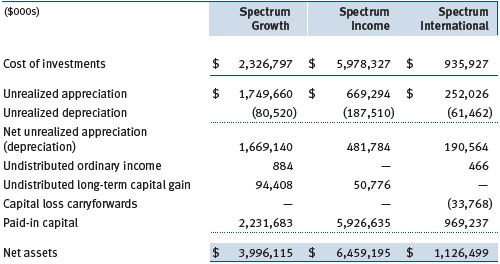
The difference between book-basis and tax-basis net unrealized appreciation (depreciation) is attributable to the deferral of losses from wash sales for tax purposes. Each fund intends to retain realized gains to the extent of available capital loss carryforwards. Because capital loss carryforwards that do not expire are required to be used before capital loss carryforwards with expiration dates, it is possible that all or a portion of the Spectrum International Fund’s capital loss carryforwards subject to expiration could ultimately go unused. During the year ended December 31, 2013, Spectrum International Fund utilized $5,985,000 of capital loss carryforwards. As of December 31, 2013, the Spectrum Growth Fund had no available capital loss carryforwards. The Spectrum Income Fund had no available capital loss carryforwards as of December 31, 2013. Additionally, as of December 31, 2013, the Spectrum International Fund had $33,768,000 of available capital loss carryforwards, which expire as follows: $26,576,000 in 2017 and $7,192,000 in 2018.
NOTE 5 - RELATED PARTY TRANSACTIONS
The Spectrum Funds are managed by T. Rowe Price Associates, Inc. (Price Associates), a wholly owned subsidiary of T. Rowe Price Group, Inc. (Price Group). Price Associates, directly or through sub-advisory agreements with its wholly owned subsidiaries, also provides investment management services to all the underlying Price funds. Pursuant to various service agreements, Price Associates and its wholly owned subsidiaries provide shareholder servicing and administrative, transfer and dividend disbursing, accounting, marketing, and certain other services to the Spectrum Funds. Certain officers and directors of the Spectrum Funds are also officers and directors of Price Associates and its subsidiaries and of the underlying Price funds.
The Spectrum Funds pay no management fees; however, Price Associates receives management fees from the underlying Price funds. The Spectrum Funds operate in accordance with the investment management and special servicing agreements between and among the corporation, the underlying Price funds and Price Associates. Pursuant to these agreements, expenses associated with the operation of the Spectrum Funds are borne by each underlying Price fund to the extent of estimated savings to it and in proportion to the average daily value of its shares owned by the Spectrum Funds. Therefore, each Spectrum Fund operates at a zero expense ratio. However, each Spectrum Fund indirectly bears its proportionate share of the management fees and operating costs of the underlying Price funds in which it invests.
The Spectrum Funds do not invest in the underlying Price funds for the purpose of exercising management or control; however, investments by the Spectrum Funds may represent a significant portion of an underlying Price fund’s net assets. At December 31, 2013, Spectrum Growth and Spectrum International each held less than 25% of the outstanding shares of any underlying Price fund; Spectrum Income held approximately 46% of the outstanding shares of the Corporate Income Fund, 40% of the GNMA Fund, and 34% of the U.S. Treasury Long-Term Fund.
Additionally, Spectrum Income is one of several mutual funds in which certain college savings plans managed by Price Associates may invest. Shareholder servicing costs associated with each college savings plan are allocated to Spectrum Income in proportion to the average daily value of its shares owned by the college savings plan and, in turn, are borne by the underlying Price funds in accordance with the terms of the investment management and special servicing agreements. At December 31, 2013, approximately 26% of the outstanding shares of Spectrum Income were held by the college savings plans.
As of December 31, 2013, T. Rowe Price Group, Inc. and its wholly owned subsidiaries owned 2,061,790 shares of Spectrum Growth, representing 1% of the fund’s net assets.
| Report of Independent Registered Public Accounting Firm |
To the Board of Directors of T.
Rowe Price Spectrum Fund, Inc. and
Shareholders of T. Rowe Price Spectrum
Growth Fund, T. Rowe Price
Spectrum Income Fund, and T. Rowe Price Spectrum
International Fund.
In our opinion, the accompanying statements of assets and liabilities, including the portfolios of investments, and the related statements of operations and of changes in net assets and the financial highlights present fairly, in all material respects, the financial position of T. Rowe Price Spectrum Growth Fund, T. Rowe Price Spectrum Income Fund and T. Rowe Price Spectrum International Fund (the funds comprising T. Rowe Price Spectrum Fund, Inc., hereafter referred to as the “Funds”) at December 31, 2013, and the results of each of their operations, the changes in each of their net assets and the financial highlights for each of the periods indicated therein, in conformity with accounting principles generally accepted in the United States of America. These financial statements and financial highlights (hereafter referred to as “financial statements”) are the responsibility of the Funds’ management; our responsibility is to express an opinion on these financial statements based on our audits. We conducted our audits of these financial statements in accordance with the standards of the Public Company Accounting Oversight Board (United States). Those standards require that we plan and perform the audit to obtain reasonable assurance about whether the financial statements are free of material misstatement. An audit includes examining, on a test basis, evidence supporting the amounts and disclosures in the financial statements, assessing the accounting principles used and significant estimates made by management, and evaluating the overall financial statement presentation. We believe that our audits, which included confirmation of the underlying funds at December 31, 2013 by correspondence with the transfer agent, provide a reasonable basis for our opinion.
PricewaterhouseCoopers LLP
Baltimore, Maryland
February 14, 2014
| Tax Information (Unaudited) for the Tax Year Ended 12/31/13 |
We are providing this information as required by the Internal Revenue Code. The amounts shown may differ from those elsewhere in this report because of differences between tax and financial reporting requirements.
The funds’ distributions included capital gain amounts as follows:

The funds will pass through foreign source income and foreign taxes paid, as follows:

For taxable non-corporate shareholders, income represents qualified dividend income subject to the 15% rate category as follows:

For corporate shareholders, income qualifies for the dividends-received deduction as follows:

| Information on Proxy Voting Policies, Procedures, and Records |
A description of the policies and procedures used by T. Rowe Price funds and portfolios to determine how to vote proxies relating to portfolio securities is available in each fund’s Statement of Additional Information. You may request this document by calling 1-800-225-5132 or by accessing the SEC’s website, sec.gov.
The description of our proxy voting policies and procedures is also available on our website, troweprice.com. To access it, click on the words “Social Responsibility” at the top of our corporate homepage. Next, click on the words “Conducting Business Responsibly” on the left side of the page that appears. Finally, click on the words “Proxy Voting Policies” on the left side of the page that appears.
Each fund’s most recent annual proxy voting record is available on our website and through the SEC’s website. To access it through our website, follow the above directions to reach the “Conducting Business Responsibly” page. Click on the words “Proxy Voting Records” on the left side of that page, and then click on the “View Proxy Voting Records” link at the bottom of the page that appears.
| How to Obtain Quarterly Portfolio Holdings |
The fund files a complete schedule of portfolio holdings with the Securities and Exchange Commission for the first and third quarters of each fiscal year on Form N-Q. The fund’s Form N-Q is available electronically on the SEC’s website (sec.gov); hard copies may be reviewed and copied at the SEC’s Public Reference Room, 100 F St. N.E., Washington, DC 20549. For more information on the Public Reference Room, call 1-800-SEC-0330.
| About the Fund’s Directors and Officers |
Your fund is overseen by a Board of Directors (Board) that meets regularly to review a wide variety of matters affecting or potentially affecting the fund, including performance, investment programs, compliance matters, advisory fees and expenses, service providers, and business and regulatory affairs. The Board elects the fund’s officers, who are listed in the final table. At least 75% of the Board’s members are independent of T. Rowe Price Associates, Inc. (T. Rowe Price), and its affiliates; “inside” or “interested” directors are employees or officers of T. Rowe Price. The business address of each director and officer is 100 East Pratt Street, Baltimore, Maryland 21202. The Statement of Additional Information includes additional information about the fund directors and is available without charge by calling a T. Rowe Price representative at 1-800-638-5660.
Independent Directors
| Name | ||
| (Year of Birth) | ||
| Year Elected* | ||
| [Number of T. Rowe Price | Principal Occupation(s) and Directorships of Public Companies and | |
| Portfolios Overseen] | Other Investment Companies During the Past Five Years | |
| William R. Brody, M.D., Ph.D. | President and Trustee, Salk Institute for Biological Studies (2009 | |
| (1944) | to present); Director, Novartis, Inc. (2009 to present); Director, IBM | |
| 2009 | (2007 to present); President and Trustee, Johns Hopkins University | |
| [157] | (1996 to 2009); Chairman of Executive Committee and Trustee, | |
| Johns Hopkins Health System (1996 to 2009) | ||
| Anthony W. Deering | Chairman, Exeter Capital, LLC, a private investment firm (2004 to | |
| (1945) | present); Director and Member of the Advisory Board, Deutsche | |
| 2001 | Bank North America (2004 to present); Director, Under Armour | |
| [157] | (2008 to present); Director, Vornado Real Estate Investment Trust | |
| (2004 to 2012) | ||
| Donald W. Dick, Jr. | Principal, EuroCapital Partners, LLC, an acquisition and management | |
| (1943) | advisory firm (1995 to present) | |
| 1999 | ||
| [157] | ||
| Bruce W. Duncan | President, Chief Executive Officer, and Director, First Industrial Realty | |
| (1951) | Trust, owner and operator of industrial properties (2009 to present); | |
| 2013 | Chairman of the Board (2005 to present), Interim Chief Executive | |
| [157] | Officer (2007), and Director (1999 to present), Starwood Hotels & | |
| Resorts, a hotel and leisure company; Senior Advisor, Kohlberg, | ||
| Kravis, Roberts & Co. LP, a global investment firm (2008 to 2009); | ||
| Trustee, Starwood Lodging Trust, a real estate investment trust and | ||
| former subsidiary of Starwood (1995 to 2006) | ||
| Robert J. Gerrard, Jr. | Advisory Board Member, Pipeline Crisis/Winning Strategies (1997 | |
| (1952) | to present); Chairman of Compensation Committee and Director, | |
| 2012 | Syniverse Holdings, Inc. (2008 to 2011); Executive Vice President | |
| [157] | and General Counsel, Scripps Networks, LLC (1997 to 2009) | |
| Karen N. Horn | Limited Partner and Senior Managing Director, Brock Capital Group, | |
| (1943) | an advisory and investment banking firm (2004 to present); Director, | |
| 2003 | Eli Lilly and Company (1987 to present); Director, Simon Property | |
| [157] | Group (2004 to present); Director, Norfolk Southern (2008 to | |
| present); Director, Fannie Mae (2006 to 2008) | ||
| Paul F. McBride | Former Company Officer and Senior Vice President, Human Resources | |
| (1956) | and Corporate Initiatives (2004 to 2010) | |
| 2013 | ||
| [157] | ||
| Cecilia E. Rouse, Ph.D. | Dean, Woodrow Wilson School (2012 to present); Professor and | |
| (1963) | Researcher, Princeton University (1992 to present); Director, MDRC | |
| 2012 | (2011 to present); Member, National Academy of Education (2010 | |
| [157] | to present); Research Associate, National Bureau of Economic | |
| Research’s Labor Studies Program (1998 to 2009 and 2011 to | ||
| present); Member, President’s Council of Economic Advisors | ||
| (2009 to 2011); Member, The MacArthur Foundation Network on | ||
| the Transition to Adulthood and Public Policy (2000 to 2008); | ||
| Member, National Advisory Committee for the Robert Wood | ||
| Johnson Foundation’s Scholars in Health Policy Research Program | ||
| (2008); Director and Member, National Economic Association | ||
| (2006 to 2008); Member, Association of Public Policy Analysis and | ||
| Management Policy Council (2006 to 2008); Member, Hamilton | ||
| Project’s Advisory Board at The Brookings Institute (2006 to 2008); | ||
| Chair of Committee on the Status of Minority Groups in the Economic | ||
| Profession, American Economic Association (2006 to 2008 and | ||
| 2012 to present) | ||
| John G. Schreiber | Owner/President, Centaur Capital Partners, Inc., a real estate | |
| (1946) | investment company (1991 to present); Cofounder and Partner, | |
| 2001 | Blackstone Real Estate Advisors, L.P. (1992 to present); Director, | |
| [157] | General Growth Properties, Inc. (2010 to present); Director, BXMT | |
| (formerly Capital Trust, Inc.), a real estate investment company | ||
| (2012 to present); Director and Chairman of the Board, Brixmor | ||
| Property Group, Inc. (2013 to present) | ||
| Mark R. Tercek | President and Chief Executive Officer, The Nature Conservancy (2008 | |
| (1957) | to present); Managing Director, The Goldman Sachs Group, Inc. | |
| 2009 | (1984 to 2008) | |
| [157] |
*Each independent director serves until retirement, resignation, or election of a successor.
Inside Directors
| Name | ||
| (Year of Birth) | ||
| Year Elected* | ||
| [Number of T. Rowe Price | Principal Occupation(s) and Directorships of Public Companies and | |
| Portfolios Overseen] | Other Investment Companies During the Past Five Years | |
| Edward C. Bernard | Director and Vice President, T. Rowe Price; Vice Chairman of the | |
| (1956) | Board, Director, and Vice President, T. Rowe Price Group, Inc.; | |
| 2006 | Chairman of the Board, Director, and President, T. Rowe Price | |
| [157] | Investment Services, Inc.; Chairman of the Board and Director, | |
| T. Rowe Price Retirement Plan Services, Inc., and T. Rowe Price | ||
| Services, Inc.; Chairman of the Board, Chief Executive Officer, | ||
| and Director, T. Rowe Price International; Chairman of the Board, | ||
| Chief Executive Officer, Director, and President, T. Rowe Price Trust | ||
| Company; Chairman of the Board, all funds | ||
| Brian C. Rogers, CFA, CIC | Chief Investment Officer, Director, and Vice President, T. Rowe Price; | |
| (1955) | Chairman of the Board, Chief Investment Officer, Director, and Vice | |
| 2006 | President, T. Rowe Price Group, Inc.; Vice President, T. Rowe Price | |
| [105] | Trust Company; Vice President, Spectrum Funds | |
| *Each inside director serves until retirement, resignation, or election of a successor. | ||
Officers
| Name (Year of Birth) | ||
| Position Held With Spectrum Funds | Principal Occupation(s) | |
| Christopher D. Alderson (1962) | Director and President–International Equity, | |
| Vice President | T. Rowe Price International; Company’s | |
| Representative, Director, and Vice President, | ||
| Price Hong Kong; Director and Vice President, | ||
| Price Singapore; Vice President, T. Rowe Price | ||
| Group, Inc. | ||
| Kimberly E. DeDominicis (1976) | Vice President, T. Rowe Price, T. Rowe Price | |
| Vice President | Group, Inc., and T. Rowe Price International | |
| Roger L. Fiery III, CPA (1959) | Vice President, Price Hong Kong, Price | |
| Vice President | Singapore, T. Rowe Price, T. Rowe Price Group, | |
| Inc., T. Rowe Price International, and T. Rowe | ||
| Price Trust Company | ||
| John R. Gilner (1961) | Chief Compliance Officer and Vice President, | |
| Chief Compliance Officer | T. Rowe Price; Vice President, T. Rowe Price | |
| Group, Inc., and T. Rowe Price Investment | ||
| Services, Inc. | ||
| Gregory S. Golczewski (1966) | Vice President, T. Rowe Price and T. Rowe Price | |
| Vice President | Trust Company | |
| Gregory K. Hinkle, CPA (1958) | Vice President, T. Rowe Price, T. Rowe Price | |
| Treasurer | Group, Inc., and T. Rowe Price Trust Company | |
| Ian D. Kelson (1956) | Director and President–International Fixed | |
| Vice President | Income, T. Rowe Price International; Vice | |
| President, T. Rowe Price and T. Rowe Price | ||
| Group, Inc. | ||
| Patricia B. Lippert (1953) | Assistant Vice President, T. Rowe Price and | |
| Secretary | T. Rowe Price Investment Services, Inc. | |
| David Oestreicher (1967) | Director, Vice President, and Secretary, T. Rowe | |
| Vice President | Price Investment Services, Inc., T. Rowe | |
| Price Retirement Plan Services, Inc., T. Rowe | ||
| Price Services, Inc., and T. Rowe Price Trust | ||
| Company; Chief Legal Officer, Vice President, | ||
| and Secretary, T. Rowe Price Group, Inc.; Vice | ||
| President and Secretary, T. Rowe Price and | ||
| T. Rowe Price International; Vice President, | ||
| Price Hong Kong and Price Singapore | ||
| Deborah D. Seidel (1962) | Vice President, T. Rowe Price, T. Rowe Price | |
| Vice President | Group, Inc., T. Rowe Price Investment Services, | |
| Inc., and T. Rowe Price Services, Inc. | ||
| Daniel O. Shackelford, CFA (1958) | Vice President, T. Rowe Price, T. Rowe Price | |
| Vice President | Group, Inc., and T. Rowe Price Trust Company | |
| Charles M. Shriver, CFA (1967) | Vice President, T. Rowe Price, T. Rowe Price | |
| President | Group, Inc., and T. Rowe Price Trust Company | |
| Robert W. Smith (1961) | Vice President, T. Rowe Price, T. Rowe Price | |
| Vice President | Group, Inc., and T. Rowe Price Trust Company | |
| Guido F. Stubenrauch (1970) | Vice President, T. Rowe Price | |
| Vice President | ||
| Mark S. Vaselkiv (1958) | Vice President, T. Rowe Price, T. Rowe Price | |
| Vice President | Group, Inc., and T. Rowe Price Trust Company | |
| Julie L. Waples (1970) | Vice President, T. Rowe Price | |
| Vice President | ||
| Richard T. Whitney, CFA (1958) | Vice President, T. Rowe Price, T. Rowe Price | |
| Vice President | Group, Inc., T. Rowe Price International, and | |
| T. Rowe Price Trust Company | ||
|
Unless otherwise noted, officers have been employees of T. Rowe Price or T. Rowe Price International for at least 5 years. | ||
Item 2. Code of Ethics.
The registrant has adopted a code of ethics, as defined in Item 2 of Form N-CSR, applicable to its principal executive officer, principal financial officer, principal accounting officer or controller, or persons performing similar functions. A copy of this code of ethics is filed as an exhibit to this Form N-CSR. No substantive amendments were approved or waivers were granted to this code of ethics during the period covered by this report.
Item 3. Audit Committee Financial Expert.
The registrant’s Board of Directors/Trustees has determined that Mr. Anthony W. Deering qualifies as an audit committee financial expert, as defined in Item 3 of Form N-CSR. Mr. Deering is considered independent for purposes of Item 3 of Form N-CSR.
Item 4. Principal Accountant Fees and Services.
(a) – (d) Aggregate fees billed for the last two fiscal years for professional services rendered to, or on behalf of, the registrant by the registrant’s principal accountant were as follows:

Audit fees include amounts related to the audit of the registrant’s annual financial statements and services normally provided by the accountant in connection with statutory and regulatory filings. Audit-related fees include amounts reasonably related to the performance of the audit of the registrant’s financial statements and specifically include the issuance of a report on internal controls and, if applicable, agreed-upon procedures related to fund acquisitions. Tax fees include amounts related to services for tax compliance, tax planning, and tax advice. The nature of these services specifically includes the review of distribution calculations and the preparation of Federal, state, and excise tax returns. All other fees include the registrant’s pro-rata share of amounts for agreed-upon procedures in conjunction with service contract approvals by the registrant’s Board of Directors/Trustees.
(e)(1) The registrant’s audit committee has adopted a policy whereby audit and non-audit services performed by the registrant’s principal accountant for the registrant, its investment adviser, and any entity controlling, controlled by, or under common control with the investment adviser that provides ongoing services to the registrant require pre-approval in advance at regularly scheduled audit committee meetings. If such a service is required between regularly scheduled audit committee meetings, pre-approval may be authorized by one audit committee member with ratification at the next scheduled audit committee meeting. Waiver of pre-approval for audit or non-audit services requiring fees of a de minimis amount is not permitted.
(2) No services included in (b) – (d) above were approved pursuant to paragraph (c)(7)(i)(C) of Rule 2-01 of Regulation S-X.
(f) Less than 50 percent of the hours expended on the principal accountant’s engagement to audit the registrant’s financial statements for the most recent fiscal year were attributed to work performed by persons other than the principal accountant’s full-time, permanent employees.
(g) The aggregate fees billed for the most recent fiscal year and the preceding fiscal year by the registrant’s principal accountant for non-audit services rendered to the registrant, its investment adviser, and any entity controlling, controlled by, or under common control with the investment adviser that provides ongoing services to the registrant were $1,691,000 and $1,802,000, respectively.
(h) All non-audit services rendered in (g) above were pre-approved by the registrant’s audit committee. Accordingly, these services were considered by the registrant’s audit committee in maintaining the principal accountant’s independence.
Item 5. Audit Committee of Listed Registrants.
Not applicable.
Item 6. Investments.
(a) Not applicable. The complete schedule of investments is included in Item 1 of this Form N-CSR.
(b) Not applicable.
Item 7. Disclosure of Proxy Voting Policies and Procedures for Closed-End Management Investment Companies.
Not applicable.
Item 8. Portfolio Managers of Closed-End Management Investment Companies.
Not applicable.
Item 9. Purchases of Equity Securities by Closed-End Management Investment Company and Affiliated Purchasers.
Not applicable.
Item 10. Submission of Matters to a Vote of Security Holders.
Not applicable.
Item 11. Controls and Procedures.
(a) The registrant’s principal executive officer and principal financial officer have evaluated the registrant’s disclosure controls and procedures within 90 days of this filing and have concluded that the registrant’s disclosure controls and procedures were effective, as of that date, in ensuring that information required to be disclosed by the registrant in this Form N-CSR was recorded, processed, summarized, and reported timely.
(b) The registrant’s principal executive officer and principal financial officer are aware of no change in the registrant’s internal control over financial reporting that occurred during the registrant’s second fiscal quarter covered by this report that has materially affected, or is reasonably likely to materially affect, the registrant’s internal control over financial reporting.
Item 12. Exhibits.
(a)(1) The registrant’s code of ethics pursuant to Item 2 of Form N-CSR is attached.
(2) Separate certifications by the registrant's principal executive officer and principal financial officer, pursuant to Section 302 of the Sarbanes-Oxley Act of 2002 and required by Rule 30a-2(a) under the Investment Company Act of 1940, are attached.
(3) Written solicitation to repurchase securities issued by closed-end companies: not applicable.
(b) A certification by the registrant's principal executive officer and principal financial officer, pursuant to Section 906 of the Sarbanes-Oxley Act of 2002 and required by Rule 30a-2(b) under the Investment Company Act of 1940, is attached.
SIGNATURES
Pursuant to the requirements of the Securities Exchange Act of 1934 and
the Investment Company Act of 1940, the registrant has duly caused this report
to be signed on its behalf by the undersigned, thereunto duly
authorized.
T. Rowe Price Spectrum Fund, Inc.
| By | /s/ Edward C. Bernard | |
| Edward C. Bernard | ||
| Principal Executive Officer | ||
| Date February 14, 2014 | ||
Pursuant to the requirements of the Securities Exchange Act of 1934 and
the Investment Company Act of 1940, this report has been signed below by the
following persons on behalf of the registrant and in the capacities and on the
dates indicated.
| By | /s/ Edward C. Bernard | |
| Edward C. Bernard | ||
| Principal Executive Officer | ||
| Date February 14, 2014 | ||
| By | /s/ Gregory K. Hinkle | |
| Gregory K. Hinkle | ||
| Principal Financial Officer | ||
| Date February 14, 2014 | ||